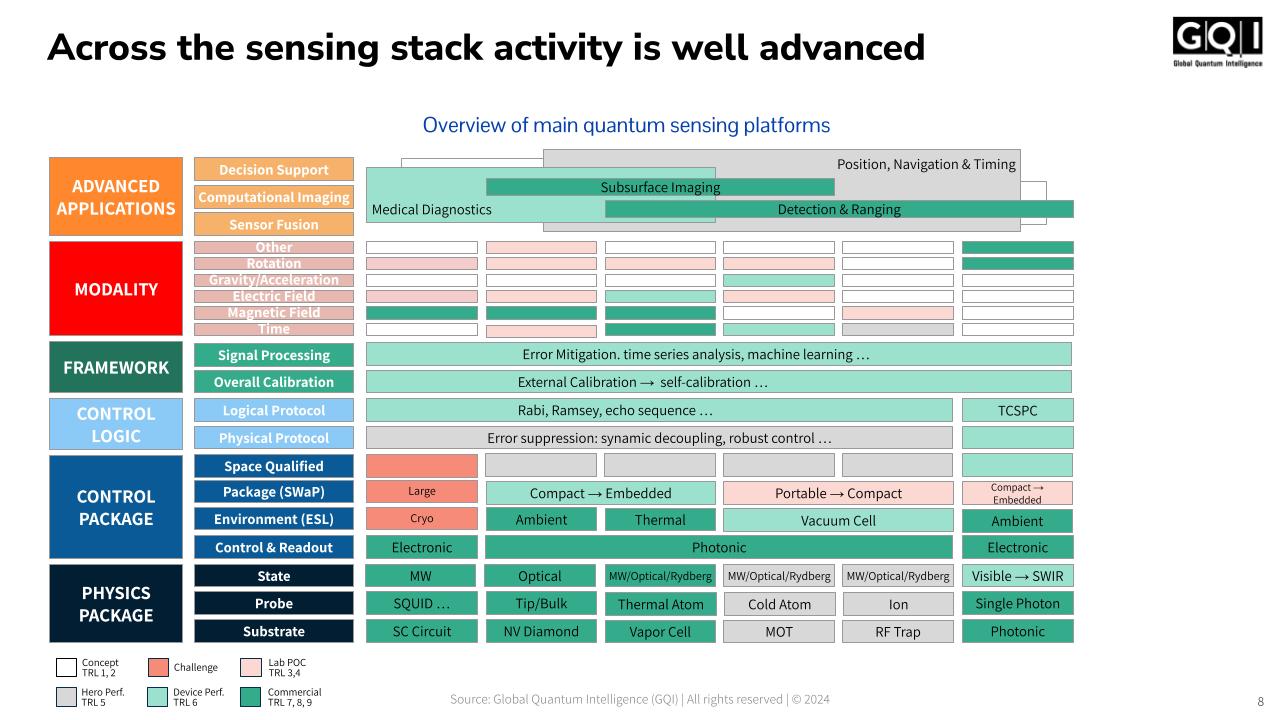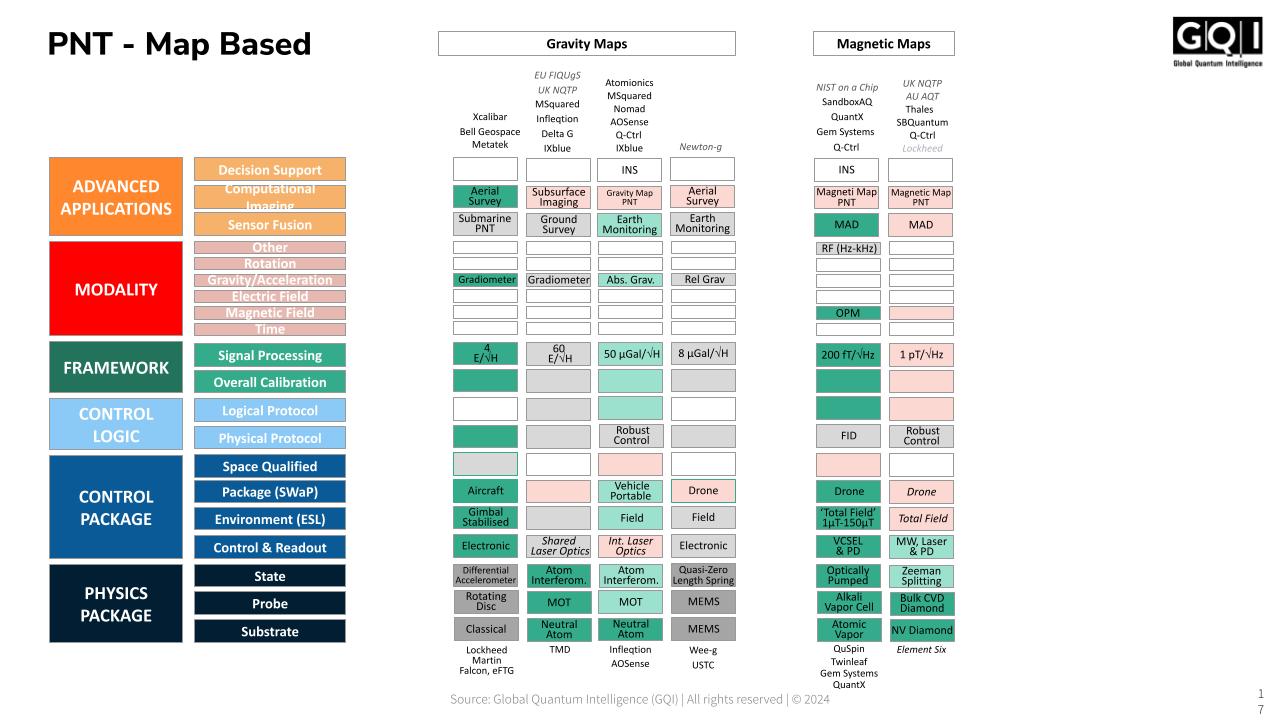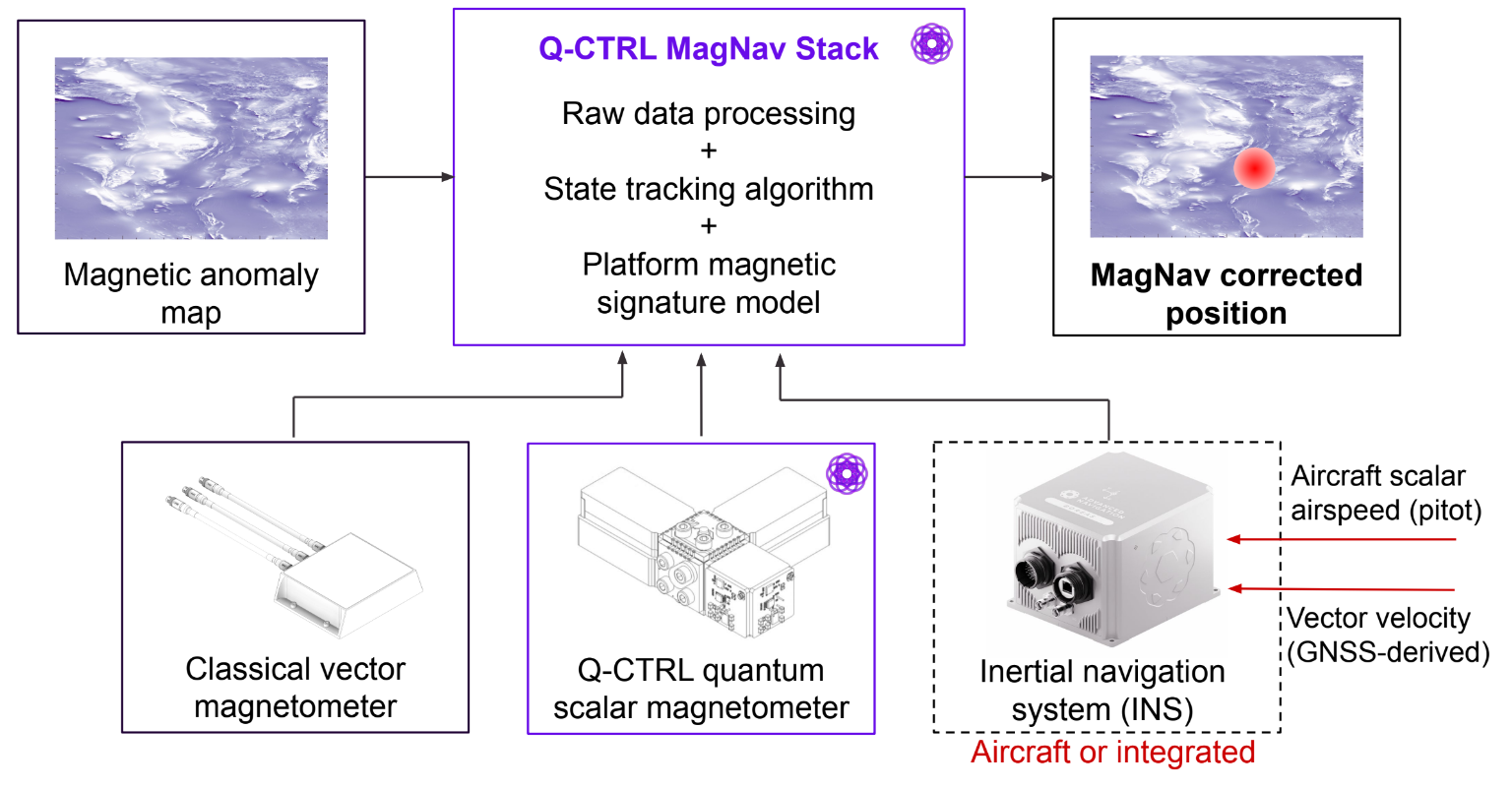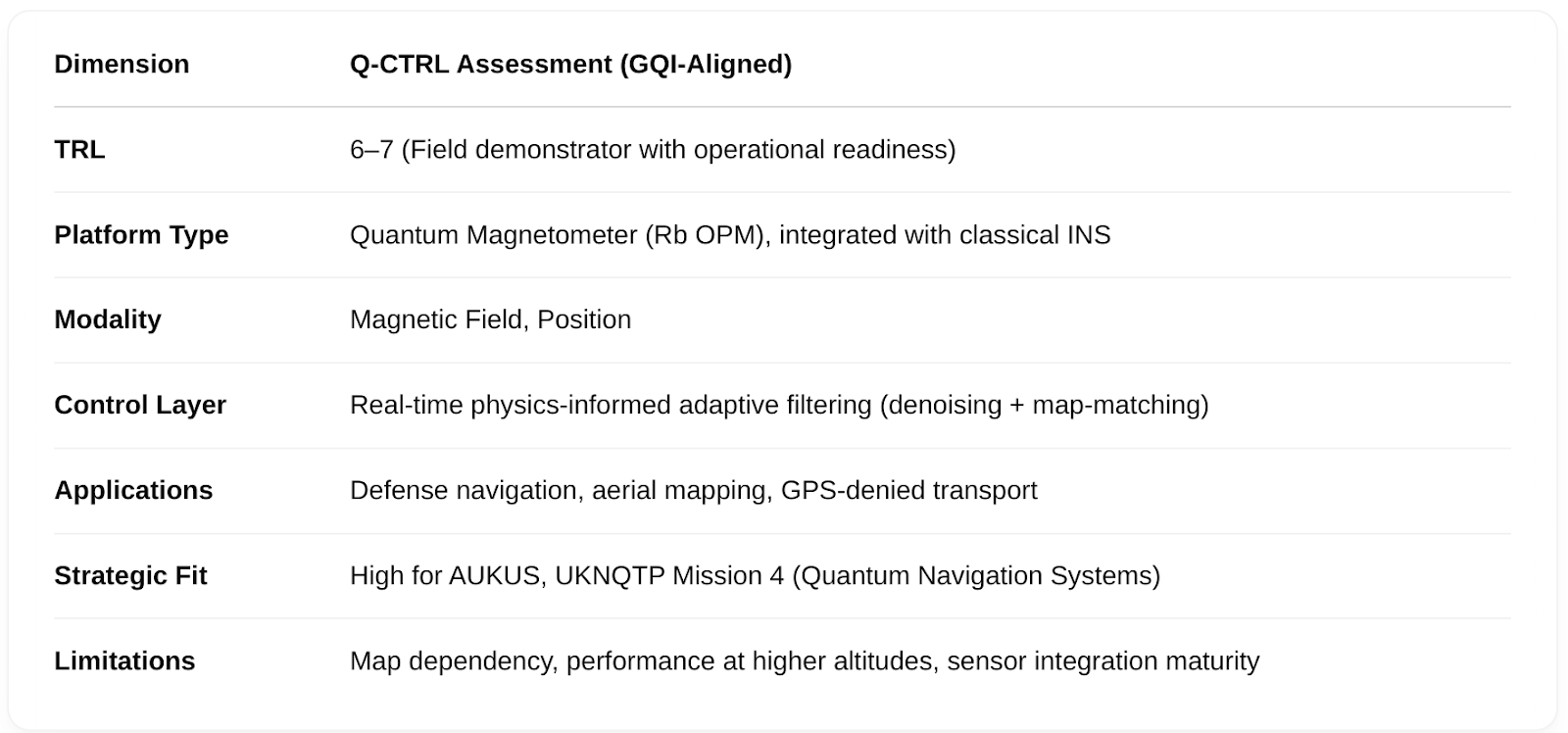
Q-CTRL reports a breakthrough in magnetic anomaly navigation (MagNav) using a quantum-assured navigation system that combines proprietary quantum magnetometers with a novel denoising and map-matching software stack. In extensive airborne and ground-based field trials, the system, named Ironstone Opal, consistently outperformed a strategic-grade inertial navigation system (INS), achieving up to 46× lower positioning error in the most favorable configuration, and at least 11× better accuracy even with internally-mounted sensors in high-noise environments. The best positioning accuracy achieved was 22 meters, or about 0.01% of flight distance, significantly surpassing both INS and active GNSS alternatives like Doppler radar. The trials demonstrated robust performance across various altitudes (ground level to 19,000 feet), under changing environmental conditions, and without requiring calibration maneuvers or prior training data.
“The team at Q-CTRL has been focused on how our unique approach to ‘AI-for-quantum’ can unlock new capabilities, rather than merely delivering better technical specs for a device.” notes Dr. Biercuk, the CEO of Q-CTRL, in a conversation with GQI. “These results show it’s now possible to use software-ruggedized quantum sensors to achieve unjammable, unspoofable, totally passive navigation with positioning-accuracy approaching GPS on real platforms. We’re excited that our vision for physics-informed AI as a powerful accelerant of quantum technology is not only upending expected timeliness for progress within the quantum sector, but also transforming the role of startups like Q-CTRL in outperforming some of the largest and best funded businesses in the world.”
Additionally, the paper reports a world-first successful demonstration of ground-based MagNav using public-domain magnetic anomaly maps, achieving 7× better positioning than INS despite extreme onboard noise, validating the potential for GPS-independent navigation in real-world defense and civilian applications. The system is relatively small and could fit into a small fixed-wing drone or an autonomous car. It also showed good reliability with an uptime of 99.97% over a wide range of environmental conditions.
Q-CTRL | AI to Maximize the Value of Quantum Technology
Q-CTRL is an Australian company founded in 2017 by Professor Michael J. Biercuk, specializing in quantum infrastructure software that enhances the performance of quantum computers and sensors by reducing noise and errors. The company offers a suite of tools including Fire Opal, which boosts algorithmic success in quantum computing; Boulder Opal, a toolkit for quantum hardware researchers; and Black Opal, an educational platform for quantum learning. With over 130 employees and offices in Sydney, Los Angeles, Berlin, and Oxford, Q-CTRL serves a wide range of clients, from Fortune 500 companies to academic institutions. Notable achievements include a $113M Series B funding round — one of the largest in quantum software — strategic partnerships with major organizations like IBM and various defense agencies, and pioneering efforts in deploying software-ruggedized quantum gravimeters on maritime vessels. The company has positioned itself as a category-defining force in both quantum computing and quantum sensing through its focus on control engineering and error mitigation.
Q-CTRL’s quantum sensing initiatives target high-impact applications across defense, navigation, geophysics, and earth observation. These include quantum-enhanced navigation in GPS-denied environments, maritime deployments, magnetic anomaly detection, and gravimetry. The company has developed software-defined quantum sensors with signal stabilization and ruggedization technologies for real-world field use. Key collaborations include projects with the US Geological Survey for geological and environmental monitoring, a partnership with Advanced Navigation for Position, Navigation, and Timing (PNT) systems, work with the Australian Department of Defence and the UK Navy, and an alliance with Airbus for advanced navigation applications. Commercially, Q-CTRL is developing a data-as-a-service platform leveraging quantum sensing to deliver precision insights on acceleration, gravity, and magnetic fields, with successful field trials validating its maritime and defense-focused technologies.
The Importance of Quantum Sensors
Quantum sensors exploit quantum mechanical phenomena such as superposition, entanglement, and quantum coherence to achieve sensitivity and precision beyond the reach of classical sensors. Among the key types are atomic clocks, which use quantum transitions in atoms like cesium or rubidium to provide unparalleled precision in timekeeping, essential for GPS, telecom, and navigation. OPMs can detect magnetic fields down to femtotesla levels, offering applications in neuroscience, geophysics, and material science. Quantum accelerometers and gravimeters leverage atom interferometry to measure acceleration and gravity with high accuracy and without drift, enabling precise inertial navigation and gravitational mapping, even in GPS-denied environments like submarines or underground surveys. Also gravitational map matching. That is the accelerometers can be used as ultra low drift INSs or as a set of eyes to see gravitational fluctuations just like our magnav uses magnetic fluctuations.

Other advanced quantum sensors include quantum thermometers, capable of measuring temperature with millikelvin sensitivity at nanoscales, valuable for biology and device diagnostics. LIDAR systems aim to enhance object detection in low-SNR or cluttered settings using entangled or squeezed light, with potential applications in aerospace and defense. Lastly, quantum RF sensors, based on highly sensitive Rydberg atoms, offer a revolutionary approach to detecting radio frequencies without traditional antennas, potentially transforming spectrum monitoring and communication in high-noise or congested environments. Across the board, quantum sensors promise a leap in performance, especially where sensitivity, stability, and precision are critical.
Quantum Sensing Applications for PNT
Quantum sensors are unlocking transformative capabilities across a wide range of applications by enabling ultra-precise, drift-free, and noise-resilient measurements. Quantum gravimeters and gradiometers support geophysics and infrastructure by detecting underground voids, mineral deposits, and structural weaknesses. In fundamental science and materials research, quantum thermometers and magnetometers offer nanoscale insights into quantum materials and devices.

Quantum sensors are poised to dramatically enhance Positioning, Navigation, and Timing (PNT) systems by providing robust, high-precision alternatives to GPS and classical inertial systems. Quantum accelerometers and gyroscopes, which rely on atom interferometry, offer drift-free inertial navigation, allowing vehicles — including submarines, spacecraft, and aircraft — to maintain precise localization over long periods without external signals. This is particularly crucial in GPS-denied environments such as underwater, indoors, underground, or during military operations where GPS jamming or spoofing is a threat. Quantum inertial sensors promise to outperform traditional IMUs by reducing error accumulation, enhancing autonomous navigation for defense and commercial aerospace, and supporting long-duration missions without the need for frequent recalibration. Gravitational and magnetic map matching eliminate drift entirely by performing position fixing to a map. That is, no matter how long the mission, the error is bounded not by time but by the details of the Map and sensor.
In parallel, atomic clocks serve as the cornerstone of secure and synchronized timekeeping across a range of PNT-critical infrastructures. Their unrivaled frequency stability ensures that time-dependent systems such as satellite constellations, telecommunications networks, and financial systems remain synchronized with nanosecond-level precision. In defense, atomic clocks enable encrypted communication, radar coordination, and precision-guided munitions. The development of optical lattice clocks and portable chip-scale atomic clocks (CSACs) is making high-performance timing solutions more compact and field-deployable. Together, quantum inertial navigation and timing systems are laying the groundwork for a resilient PNT ecosystem that operates independently of satellite-based signals, enhancing both strategic autonomy and reliability in critical missions.
Q-CTRL Magnetic Navigation Sensors
Q-CTRL’s today announced a significant breakthrough in quantum-assisted magnetic navigation (MagNav), demonstrating performance that surpasses traditional strategic-grade inertial navigation systems (INS) in GPS-denied environments. The system combines optically pumped quantum magnetometers with a proprietary software stack that performs quasi real-time signal denoising and map-matching. In airborne trials, the solution achieved up to 46× better accuracy than INS, with positioning errors as low as 22 meters — just 0.006% of flight distance. Ground-based demonstrations using public-domain magnetic anomaly maps further validated its utility, achieving a 7× improvement over classical INS even under extreme magnetic interference, underscoring its operational versatility.

The system’s core strength lies in its vertical integration of hardware and software across the quantum sensing stack. The magnetometers deliver sub-100 fT/√Hz sensitivity in compact form factors suitable for aircraft and autonomous platforms, while the software architecture is robust to environmental variability, offering cold-start capabilities without calibration or pretraining. This aligns closely with GQI’s midstack emphasis on real-time control, adaptive signal processing, and embedded sensor intelligence. The architecture supports real-time decision-making and integration with broader PNT frameworks, situating the system well for both military and civilian navigation use cases where GNSS signals are unreliable or unavailable.
This turns the Q-CTRL solution into a “system of systems” approach, critical to end user success.

What GQI is Watching
Challenges remain in scaling the solution for widespread deployment. Performance is dependent on the availability and resolution of magnetic anomaly maps, which may vary by geography, particularly over oceanic and polar regions. While the system proved resilient to noise, its best performance still requires externally mounted sensors, raising questions about integration into sealed platforms or commercial aircraft hulls. Finally, while the system appears to have reached TRL 6–7, further validation will be necessary to meet defense certification requirements and integrate into mission-critical avionics stacks. These limitations reflect broader trends flagged in the GQI framework, particularly in ensuring environmental hardening, seamless integration, and data infrastructure maturity.
Quantum Advantage or Bust
Quantum advantage refers to the point at which a quantum device or algorithm outperforms the best known classical counterpart at a given task — either in terms of speed, precision, resource efficiency, or scalability — in a way that is practically meaningful.
In the context of quantum sensors, quantum advantage typically means achieving greater sensitivity, resolution, or stability than is possible with classical sensors, often by exploiting uniquely quantum phenomena like superposition, entanglement, or quantum coherence. This allows quantum sensors to detect extremely weak signals, measure minute changes in physical quantities, or maintain accuracy over time without drift, opening up capabilities not accessible through classical means.
The Q-CTRL MagNav system does meet the criteria for quantum advantage, according to GQI, specifically within the quantum sensing domain — though with important nuances.
In quantum sensing, we define quantum advantage as achieving practical performance beyond what is possible with the best classical systems, enabled by leveraging quantum phenomena like superposition, coherence, or quantum measurement sensitivity. In this case, Q-CTRL’s system uses quantum magnetometers to detect ambient magnetic fields with extremely high sensitivity and stability. When coupled with their software stack, this system achieved up to 46× improved accuracy in airborne navigation and 7× improvement in ground-based positioning compared to strategic-grade classical INS. These are not incremental gains — they are orders of magnitude improvements under realistic, noisy conditions and without external references like GPS or radar.
This is a domain-specific quantum advantage, meaning it does not involve outpacing classical computation but rather outperforming classical sensors in precision and resilience. It’s also a practical and measurable advantage, not just a laboratory benchmark. The system’s capability to function without calibration, in real-time, and in high-interference environments further distinguishes it from classical systems which typically require signal corrections, drift compensation, or external aids.
Developments to Come
The advantage is currently bounded by certain infrastructure constraints — primarily the quality of magnetic anomaly maps and the integration constraints of magnetometer placement. These do not negate the quantum advantage, but they affect scalability and generalizability, which are factors in broader strategic adoption. As GQI notes, achieving full-spectrum quantum advantage also involves ecosystem maturity — interfacing sensors with broader decision systems, qualification, and long-term robustness.
Q-CTRL’s MagNav system exhibits quantum advantage in sensing, with clear, application-relevant outperformance of classical systems. It sets a benchmark for what quantum navigation can deliver in operational contexts, especially for GPS-denied defense and aerospace applications.
Congratulations to the entire team in Sydney, Los Angeles, San Francisco, Oxford and Berlin for achieving quantum advantage in sensing for PNT!
For more about Q-CTRL’s quantum sensing activity, you can view a press release posted on their website HERE, and also a technical paper posted HERE.
April 14, 2025


